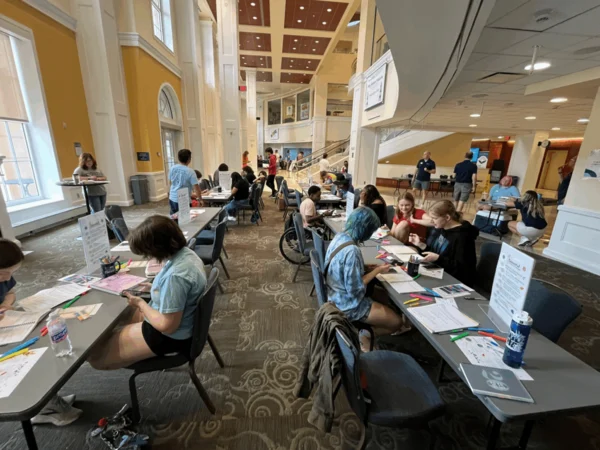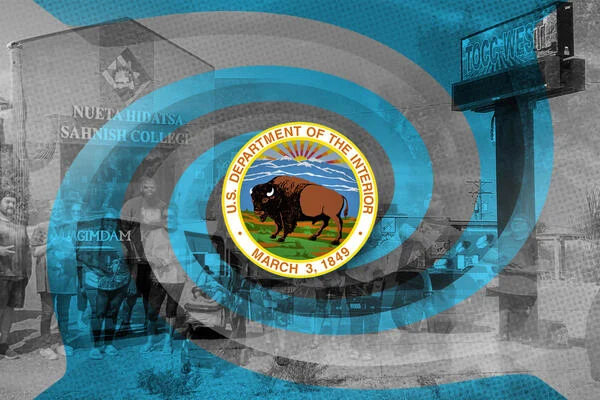House Republicans held a hearing Wednesday broadcasting long-standing conservative allegations of a left-wing bias in the small, prestigious Truman Scholarship program. Witnesses called by the GOP said the winners disproportionately espouse causes such as promoting racial justice and fighting climate change—and wind up working for Democrats and left-leaning organizations—while few recipients profess interest in conservative aims.
But rather than counter the allegations, Democrats and their invited witness largely called the proceedings a distraction from the issue of college unaffordability, which they accused the GOP of exacerbating.
The Subcommittee on Higher Education and Workforce Development hearing reflected a trend in conservative criticism of higher ed: allegations of favoritism toward liberals and left-leaning thought within very exclusive programs, including certain Ivy League institutions. The Trump administration’s sweeping research funding cuts for particular universities—and the congressional grillings of university presidents during antisemitism hearings before Trump retook the White House—have targeted institutions that only a fraction of Americans attend.
“The Truman Scholarship represents an appropriation of $3 million a year, and directly impacts just 50 to 60 students annually,” said Democratic witness Ashley Harrington, senior policy counsel for the NAACP Legal Defense Fund. “The cuts to the higher education safety net made in the One Big Beautiful Bill are of far greater consequence to the millions of Americans who have never even heard of the Truman Scholarship.”
“I hope today’s conversation can shift toward making our entire higher education system more affordable and accessible for all students,” Harrington said, “instead of having a narrow, partisan dialogue about the very few who receive this elite scholarship.”
Republicans and their witnesses—one from a conservative-leaning media outlet and two from conservative-leaning think tanks—didn’t take her up on that invitation. Jennifer Kabbany, editor in chief of The College Fix, said her outlet has been researching liberal bias in the Truman Scholarship for 10 years and argued that its recipients hold a lot of sway.
“They’re lobbying, they’re working for lawmakers, they’re consulting, they’re working for very influential, liberal-leaning law firms,” Kabbany said. “And so they’re having a big influence on our nation’s conversation and what legislation is brought forth. This isn’t just a $3 million scholarship—this is the direction of our country.”
The scholarship, which provides junior undergraduates up to $30,000 for a “public service–related” graduate degree, was founded as a memorial to the namesake Democratic president. Congress passed legislation creating it in 1974, and Republican president Gerald Ford signed the bill into law the next year.
Lawmakers didn’t invite anyone from the Harry S. Truman Scholarship Foundation to testify. Rep. Burgess Owens, the Utah Republican who chairs the subcommittee, told Inside Higher Ed he didn’t know why no one from the foundation appeared. Audra McGeorge, communications director for the Education and Workforce Committee, said the full committee chooses witnesses.
“We provided an opportunity for the Truman Scholarship program to respond to the Committee’s concerns” outlined in a letter last year citing a report on the program from the American Enterprise Institute, McGeorge said. “Since they chose not to engage with us on those issues, we did not see a productive path in repeating the outreach. So we sought out researchers who have examined this issue fairly.”
The minority Democratic party gets to choose only one witness. Raiyana Malone, a spokesperson for the committee’s Democrats, said, “We really wanted to focus on the Big Ugly Bill cuts to higher education,” so they chose Harrington.
The report from AEI, a conservative-leaning think tank, said that, of the 182 Truman winners between 2021 and 2023, just six espoused interest in a traditionally “conservative-leaning” cause. While numerous winners cited an interest in topics such as immigrants’ rights or racial justice, none professed interest in protecting the rights of the unborn or defending the Second Amendment, the report said.
Frederick Hess, AEI’s director of education policy studies and co-author of the report, said the Truman Foundation began hiding past news releases and reduced the amount of biographical information on its website to prevent the replication of such studies. In an email, Tara Yglesias, the foundation’s deputy executive secretary, said its 2025 scholar listing had returned to a format used in the early 2000s partly because “scholars, particularly those working in national security and similar areas, had made requests that we not post their biographical information publicly. Additionally, significant staff time was required to keep the biographies current, even for the short time they were visible.”
Rep. Suzanne Bonamici, an Oregon Democrat, criticized the fact that the report’s other author, Joe Pitts, didn’t disclose in the report that he was a failed applicant for the scholarship. Bonamici called Pitts “disgruntled,” which Pitts rebutted on X.
The scholarship foundation didn’t provide Inside Higher Ed an interview Wednesday or answer some specific emailed questions. Terry Babcock-Lumish, its executive secretary, wrote in an email that while no one from the foundation was invited to testify, “We welcome Members of Congress’s assistance in raising awareness of our opportunity and hope they will encourage the colleges and universities in their districts to nominate qualified candidates.” She said it’s “a merit-based scholarship program committed to identifying aspiring leaders throughout the United States, regardless of ideology.”
“Unless candidates apply, we cannot select them,” she wrote.
While the Republican witnesses shared their specific issues with the program’s recruitment and selection process—including not seeking out candidates from traditionally conservative campuses—they and the Republican subcommittee members also traced the alleged liberal bias to the left-leaning nature of academe in general.
“On the campus level, those that are deciding who gets put to the regional committees, I mean, they’re professors,” said Kabbany, of The College Fix. “And we all know, 30 to one, professors are liberals, so they’re obviously going to advance candidates who have beliefs and pet causes that they love … It’s really systemic.”
A few Republicans, including Owens, said Congress should end the program.
“The Truman committee and this entire process is anti-conservative,” Owens said in his closing remarks. He said, “This has been a pipeline for Democrats, no question about it … I don’t think it’s fixable.”
Rep. Mark Harris, a North Carolina Republican, said, “It’s deeply ironic to me that taxpayers who also never attended college, just like [President] Truman himself, are now forced to fund elite postgraduate degrees for a handpicked few. In my opinion, the federal government has no business running a scholarship program at all.” (According to the Truman Library, Harry S. Truman attended a business college for one year before dropping out to help with his father’s business.)
Two Republicans—current New York gubernatorial candidate Elise Stefanik and Rep. Randy Fine, a staunchly pro-Israel Florida Republican who has said, “We have a Muslim problem in America”—accused the program of fostering antisemitism. “This, to me, is beyond liberal bias,” Fine said. “This is a flat-out embrace of Muslim terror and [represents] the fact that U.S. taxpayer dollars are being used to fund terrorists.”
Fine, who is Jewish, said, “I have zero desire to reform the Truman fellowship. I’m not interested in borrowing $3 million from my children and grandchildren to give it to people who would like to kill them, so I believe we should shut down the program.” (Fine also made a point to say he wasn’t asking questions of Adam Kissel, a Republican witness, because of Kissel’s connection to the Heritage Foundation, which many conservatives accuse of tolerating antisemitism.)
Stefanik, who is on the scholarship foundation’s board, cited a 2025 Truman scholar who “publicly espoused support for Hamas,” adding, “We need to address this rise in antisemitism with some of the recipients.”
Eva Frazier, the Truman recipient whom Stefanik has publicly named in the past, told Inside Higher Ed in an email, “Congresswoman Stefanik’s comments followed a long pattern of politicians attempting to scare students into silence for speaking out about the Palestinian cause, but we refuse to be intimidated by such attacks.”
Rep. Tim Walberg, a Michigan Republican and chair of the Education and Workforce Committee, said the alleged Truman Scholarship issues are “illustrative of so much that goes on.”
“We’re seeing a bias in opposition to the American idea,” he said. “That isn’t liberal or conservative—it’s American.”








